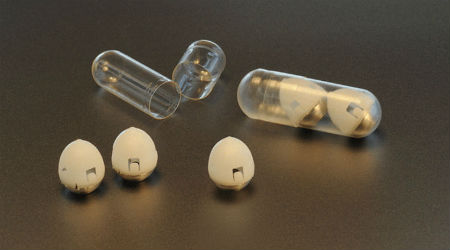|
NOVIDADES
Taken orally, the capsule is said to contain a small needle made of compressed insulin, which is injected after the capsule reaches the stomach. In animal tests, the MIT-led research team showed they could deliver insulin and lower blood sugar at levels comparable to injections through skin. “We are really hopeful that this new type of capsule could someday help diabetic patients and perhaps anyone who requires therapies that can now only be given by injection or infusion,” said Robert Langer, the David H Koch Institute Professor, a member of MIT’s Koch Institute for Integrative Cancer Research, and one of the senior authors of the study.  A self-righting capsule that delivers insulin could one day replace daily injections administered by people with type 1 diabetes. Pic: Felice Frankel
According to MIT, the tip of the needle is made of nearly 100 per cent compressed, freeze-dried insulin, using the same process used to form medicine tablets. The shaft of the needle, which does not enter the stomach wall, is made from another biodegradable material. Within the capsule, the needle is attached to a compressed spring that is held in place by a disk made of sugar. When the capsule is swallowed, water in the stomach dissolves the sugar disk, releasing the spring and injecting the needle into the stomach wall. The stomach wall has no pain receptors, so the researchers believe that patients would not be able to feel the injection. To ensure that the drug is injected into the stomach wall, the researchers designed their system so that no matter how the capsule lands in the stomach, it can orient itself so the needle is in contact with the stomach lining. “As soon as you take it, you want the system to self-right so that you can ensure contact with the tissue,” Traverso said. Once the tip of the needle is injected into the stomach wall, the insulin dissolves at a rate that can be controlled by the researchers as the capsule is prepared. In this study, it took about an hour for all of the insulin to be fully released into the bloodstream. In tests in pigs, the researchers showed that they could deliver up to 300 micrograms of insulin. More recently, they have been able to increase the dose to 5 milligrams, which is comparable to the amount that a patient with type 1 diabetes would need to inject. After the self-righting capsule releases its contents, it can pass through the digestive system. The researchers found no adverse effects from the capsule, which is made from biodegradable polymer and stainless steel components. The MIT team is now continuing to work with Novo Nordisk to further develop the technology and optimise the manufacturing process for the self-righting capsule devices. The Engineer. Posted: Feb 11, 2019. Administração de insulina por via oral - mais eficaz, mais fácil! Às voltas com o diabetes? Troque a picada diária por uma cápsula. Diabetes: uma rede inteligente de nanopartículas para tratar a doença. |
|||||||||||||||||||||||||